Fiber Bragg Gratings Based Cyclic Strain Measuring of Weld Toes of Cruciform Joints
Abstract
1. Introduction
2. Theoretical Context
2.1. SCF of Welds
2.2. Cyclic Stress-Strain Response Behavior
- (1)
- For the first loading cycle, σa is calculated according to εa by cyclic stress-strain curve (Equation (7)), in which εa is obtained from the strain testing data.
- (2)
- For other cycles, the hysteresis loop curve (Equation (8)) is used to calculate ∆σ according to ∆ε, in which ∆ε is obtained by rain flow counting for the strain testing data.
2.3. FBG Strain Sensor
3. Test Configuration
3.1. Specimen Description
3.2. Testing Points
3.3. Test Procedure
4. Results
4.1. Time History
4.2. Stress-Strain Response Curve
5. Discussion
6. Conclusions
- (1)
- FBG has small section size, good flexural resistance and can be arranged across the characteristic points at the weld toe. Compared with other strain sensors, it can obtain the complete cyclic strain time history of the weld toe more accurately and reliably, which has great advantages for the experimental investigation and SHM for welded structures.
- (2)
- Under the cyclic loading, the strain time history of the weld toe can be divided into three distinct phases, in which cyclic hardening effect in the early phase and plastic flow behavior in the final phase are obvious and influence greatly on the mechanical behaviors for welded joints.
- (3)
- Both experiment investigation and theoretical analysis show that the local stress and strain state at the weld toe is the vital factor which affects the fatigue performance of welded joints without considering the weld defects. Geometric points such as convex vertexes of the arc segment are potential positions for fatigue damage, which should be paid more attention to.
- (4)
- Generally, the weld toe curves of welded joints are irregular, which result in variable SCF along the weld toe. Under cyclic loads, different geometry characteristic points along the weld toe satisfy the crack initiation condition one after another, resulting in multiple cracks of the weld toe and their unsynchronized initiation moment.
Author Contributions
Funding
Acknowledgments
Conflicts of Interest
References
- Radaj, D. Review of fatigue strength assessment of nonwelded and welded structures based on local parameters. Int. J. Fatigue 1996, 18, 153–170. [Google Scholar] [CrossRef]
- Radaj, D.; Sonsino, C.M.; Fricke, W. Recent developments in local concepts of fatigue assessment of welded joints. Int. J. Fatigue 2009, 31, 2–11. [Google Scholar] [CrossRef]
- Jonsson, M.B.; Samuelsson, J.; Marquis, G.B. Development of weld quality criteria based on fatigue performance. Weld. World 2011, 55, 79–88. [Google Scholar] [CrossRef]
- Schijve, J. Fatigue predictions of welded joints and the effective notch stress concept. Int. J. Fatigue 2012, 45, 31–38. [Google Scholar] [CrossRef]
- Sonsino, C.M.; Fricke, W.; Bruyne, F.D.; Hoppe, A.; Ahmadi, A.; Zhang, G. Notch stress concepts for the fatigue assessment of welded joints–Background and applications. Int. J. Fatigue 2012, 34, 2–16. [Google Scholar] [CrossRef]
- Gurney, T.R. Fatigue of Welded Struct; Cambridge University Press: Cambridge, UK, 1978. [Google Scholar]
- Radaj, D.; Sonsino, C.M. Fatigue Assessment of Welded Joints by Local Approaches; Woodhead Publishing: Cambridge, UK, 1998. [Google Scholar]
- Lassen, T.; Recho, N. FLAWS–Fatigue Life Analyses of Welded Structures; ISTE: Washington, DC, USA, 2006. [Google Scholar]
- Ye, N.; Moan, T. Improving fatigue life for aluminimum cruciform joints by weld toe grinding. Fatigue Fract. Eng. Mater. Struct. 2008, 31, 152–163. [Google Scholar] [CrossRef]
- Nykanen, T.; Marquis, G.; Bjork, T. A simplified fatigue assessment method for high quality welded cruciform joints. Int. J. Fatigue 2009, 31, 79–87. [Google Scholar] [CrossRef]
- He, B.L.; Yu, Y.X.; Zhang, X.D.; Xia, S.S. Calculation about Stress Concentration Coefficient of Welded Cruciform Joints of Magnesium Alloy Based on FEM. Adv. Mater. Res. 2014, 989–994, 931–934. [Google Scholar] [CrossRef]
- Brennan, F.P.; Peleties, P.; Hellier, A.K. Predicting weld toe stress concentration factors for T and skewed T-joint plate connections. Int. J. Fatigue 2000, 22, 573–584. [Google Scholar] [CrossRef]
- Ramalho, A.L.; Ferreira, J.A.; Branco, C.A. Fatigue behaviour of T welded joints rehabilitated by tungsten inert gas and plasma dressing. Mater. Des. 2011, 32, 4705–4713. [Google Scholar] [CrossRef]
- Radaj, D. Theory of forces and stresses in spot welded overlap joints. Arch. Appl. Mech. 1996, 67, 22–34. [Google Scholar] [CrossRef]
- Tsuyoshi, S.; Naoki, Y.; Yoshikiyo, T.; Jiro, H.; Kazuhiro, O. Effect of weld toe geometry on fatigue life of lap fillet jointed ultra-high strength steel joints. Int. J. Fatigue 2018, 116, 409–420. [Google Scholar]
- Deng, D.; Murakawa, H.; Liang, W. Numerical and experimental investigations on welding residual stress in multi-pass butt-welded austenitic stainless steel pipe. Comput. Mater. Sci. 2008, 42, 234–244. [Google Scholar] [CrossRef]
- Steimbreger, C.; Chapetti, M.D. Fatigue strength assessment of butt-welded joints with undercuts. Int. J. Fatigue 2017, 105, 296–304. [Google Scholar] [CrossRef]
- Pandey, C.; Giri, A.; Mahapatra, M.M. On the prediction of effect of direction of welding on bead geometry and residual deformation of double-sided fillet joints. Int. J. Steel Struct. 2016, 16, 333–345. [Google Scholar] [CrossRef]
- Kainuma, S.; Mori, T. A fatigue strength evaluation method for load-carrying fillet jointed cruciform joints. Int. J. Fatigue 2006, 28, 864–872. [Google Scholar] [CrossRef]
- Lee, C.H.; Chang, K.H.; Jang, G.C.; Lee, C.Y. Effect of weld geometry on the fatigue life of non-load-carrying fillet jointed cruciform joints. Eng. Fail. Anal. 2009, 16, 849–855. [Google Scholar] [CrossRef]
- Kiyak, Y.; Madia, M.; Zerbst, U. Extended parametric equations for weld toe stress concentration factors and through-thickness stress distributions in butt-welded plates subject to tensile and bending loading. Weld. World 2016, 60, 1–13. [Google Scholar] [CrossRef]
- Djoković, J.M.; Nikolić, R.R. Influence of the Joint Geometry on the Stress Intensity Factor of the Fillet jointed Cruciform Joint Subjected to Tension and Bending. Mater. Today Proc. 2016, 3, 959–964. [Google Scholar] [CrossRef]
- Meneghetti, G.; Campagnolo, A.; Berto, F. Fatigue strength assessment of partial and full-penetration steel and aluminium butt-welded joints according to the peak stress method. Fatigue Fract. Eng. Mater. Struct. 2015, 38, 1419–1431. [Google Scholar] [CrossRef]
- Hou, C.Y. Fatigue analysis of welded joints with the aid of real three-dimensional weld toe geometry. Int. J. Fatigue 2007, 29, 772–785. [Google Scholar] [CrossRef]
- Kang, J.; Ososkov, Y.; Embury, J.D.; Wilkinson, D.S. Digital image correlation studies for microscopic strain distribution and damage in dual phase steels. Scr. Mater. 2007, 56, 999–1002. [Google Scholar] [CrossRef]
- Agarwal, G.; Gao, H.; Amirthalingam, M.; Hermans, M.J.M. In-situ strain investigation during laser welding using digital image correlation and finite element based numerical simulation. Sci. Technol. Weld. Join. 2017, 23, 1–6. [Google Scholar] [CrossRef]
- Otegui, J.L.; Mohaupt, U.H.; Burns, D.J. A strain gauge technique for monitoring small fatigue cracks in welds. Eng. Fract. Mech. 1991, 40, 549–569. [Google Scholar] [CrossRef]
- Lukashevich, A.O.; Leonets’, V.A.; Chaus, L.M. Strain-Gauge Method of Detecting Subcritical Fatigue Cracks in Low-Carbon Steel Welds. Strength Mater. 2015, 47, 467–473. [Google Scholar] [CrossRef]
- Takeuchi, K. Locations of strain gauges for fatigue analysis of welded joints (1). Weld. Int. 2012, 26, 559–566. [Google Scholar] [CrossRef]
- Takeuchi, K. Locations of strain gauges for fatigue analysis of welded joints (2). Weld. Int. 2012, 26, 655–664. [Google Scholar] [CrossRef]
- Mirapeix, J.; Cobo, A.; Conde, O.M. Real-time arc welding defect detection technique by means of plasma spectrum optical analysis. NDT&E Int. 2006, 39, 356–360. [Google Scholar]
- Zhang, X.J.; Chen, J.; Álvaro, G.V.; Liu, F. Twist sensor based on surface plasmon resonance excitation using two spectral combs in one tilted fiber Bragg grating: publisher’s note. J. Opt. Soc. Am. B 2019, 36, 1176–1182. [Google Scholar] [CrossRef]
- Ye, X.W.; Su, Y.H.; Xi, P.S. Statistical Analysis of Stress Signals from Bridge Monitoring by FBG System. Sensors 2018, 18, 491. [Google Scholar]
- Hu, D.T.; Guo, Y.X.; Chen, X.F.; Zhang, C.R. Cable Force Health Monitoring of Tongwamen Bridge Based on Fiber Bragg Grating. Appl. Sci. 2017, 7, 384. [Google Scholar] [CrossRef]
- Güemes, A.; Fernández-López, A.; Díaz-Maroto, P. Structural Health Monitoring in Composite Structures by Fiber-Optic Sensors. Sensors 2018, 18, 1094. [Google Scholar] [CrossRef] [PubMed]
- Mitchell, M.R.; Rockwell Science Center. Fundamentals of Modern Fatigue Analysis for Design. Fatigue Fract. ASM Handb. Comm. 1996, 19, 227–249. [Google Scholar]
- Xiong, L.; Jiang, G.; Guo, Y. A Three-dimensional Fiber Bragg Grating Force Sensor for Robot. IEEE Sens. J. 2018, 9, 3632–3639. [Google Scholar] [CrossRef]
- Wu, L.; Maheshwari, M.; Yang, Y.; Xiao, W. Selection and Characterization of Packaged FBG Sensors for Offshore Applications. Sensors 2018, 18, 3963. [Google Scholar] [CrossRef] [PubMed]
- Luo, Y.R.; Wang, Q.Y.; Liu, Y.J. Low cycle fatigue properties of steel structure materials Q235 and Q345. J. Sichuan Univ. 2012, 44, 169–175. [Google Scholar]
- Qin, D.; Ping, Y.; Geng, X.; Deng, J.L. Mechanisms and modeling of low cycle fatigue crack propagation in a pressure vessel steel Q345. Int. J. Fatigue 2016, 89, 2–10. [Google Scholar]
- Zerbst, U.; Ainsworth, R.A.; Beier, H.T. Review on fracture and crack propagation in weldments–A fracture mechanics perspective. Eng. Fract. Mech. 2014, 132, 200–276. [Google Scholar] [CrossRef]
- Jinachandran, S.; Li, H.; Xi, J. Fabrication and Characterization of a Magnetized Metal-Encapsulated FBG Sensor for Structural Health Monitoring. IEEE Sens. J. 2018, 18, 8739–8746. [Google Scholar] [CrossRef]
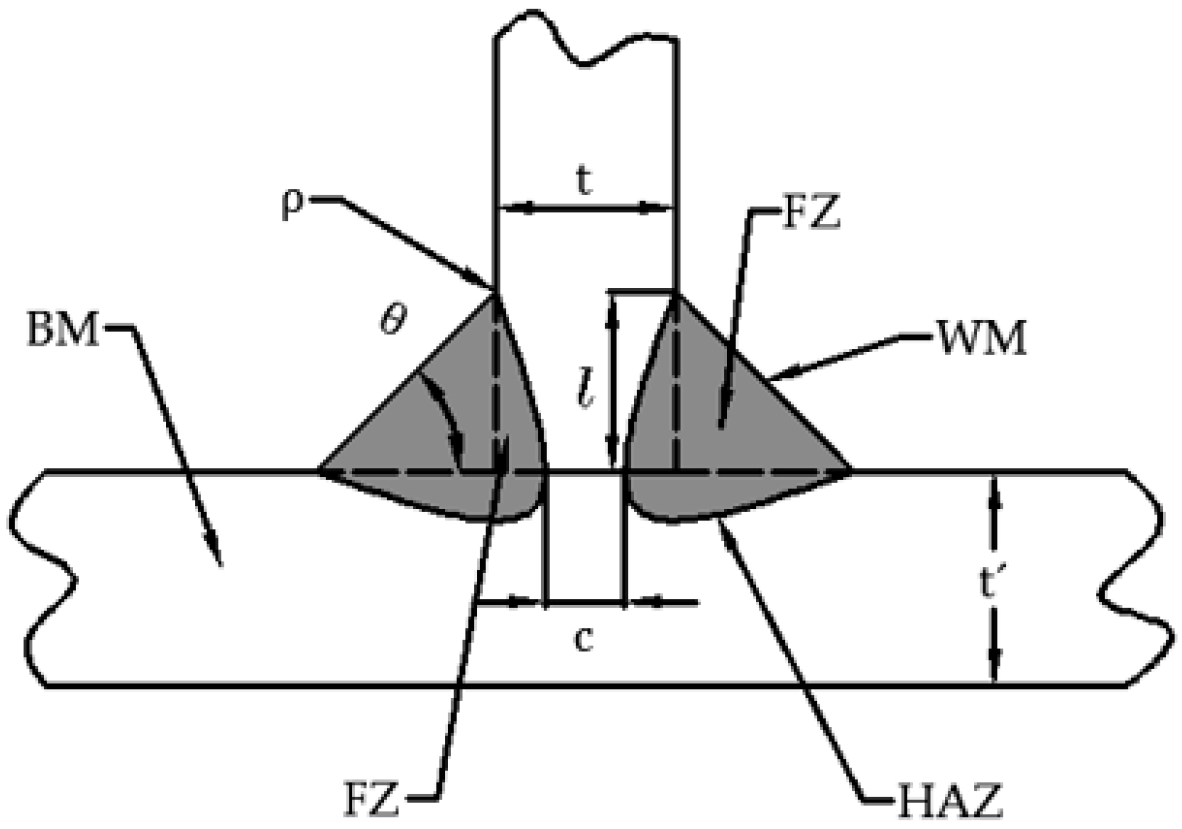
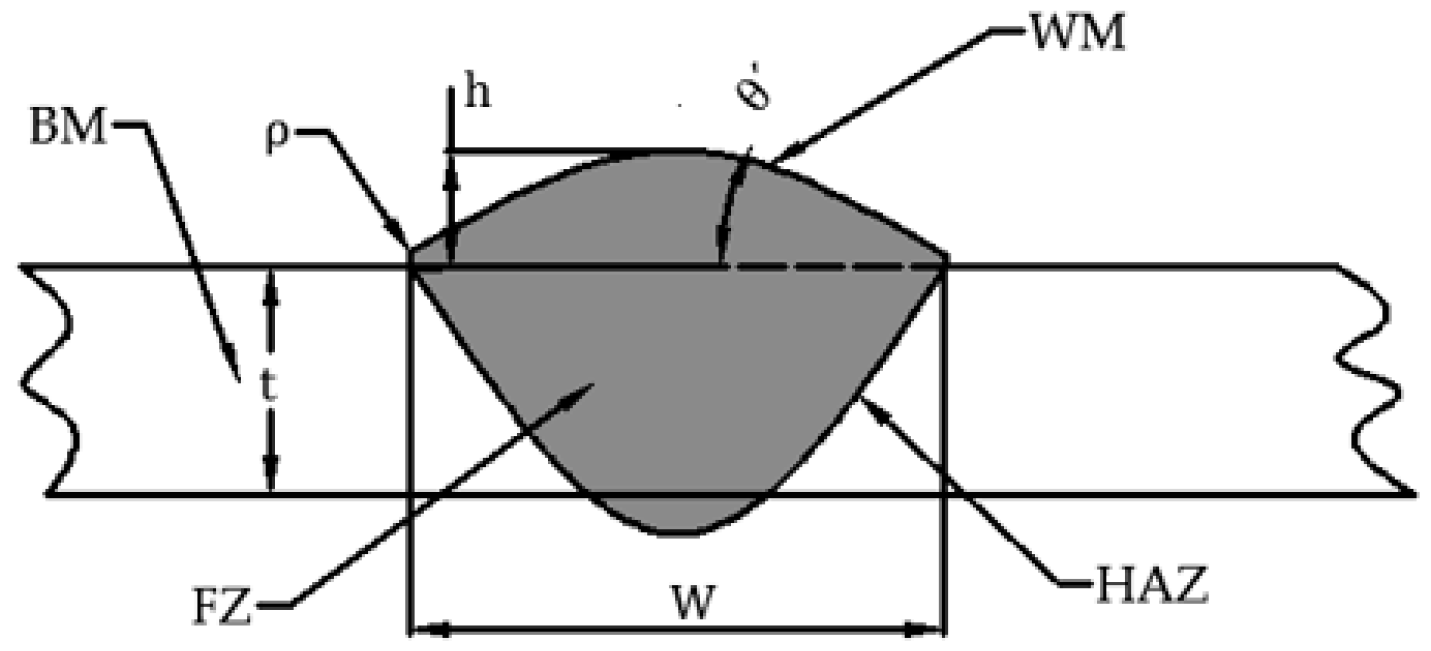
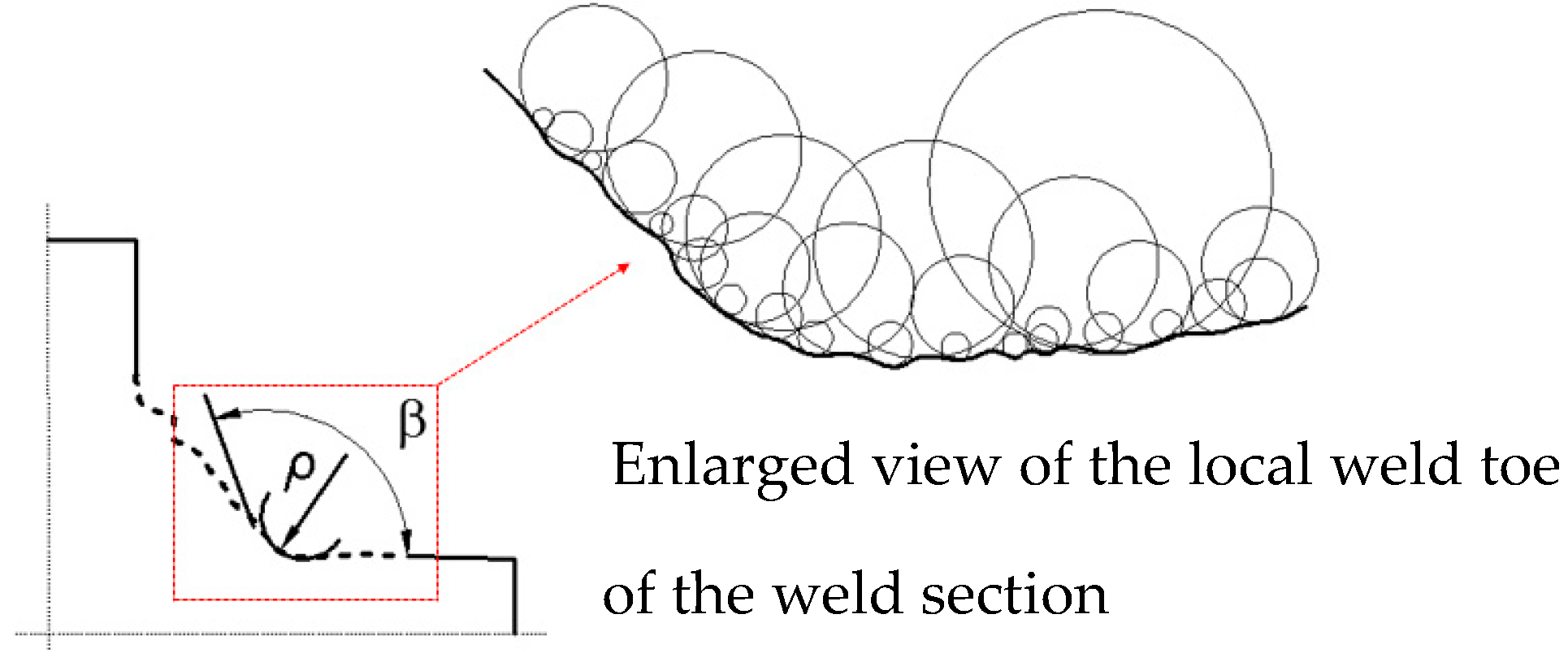
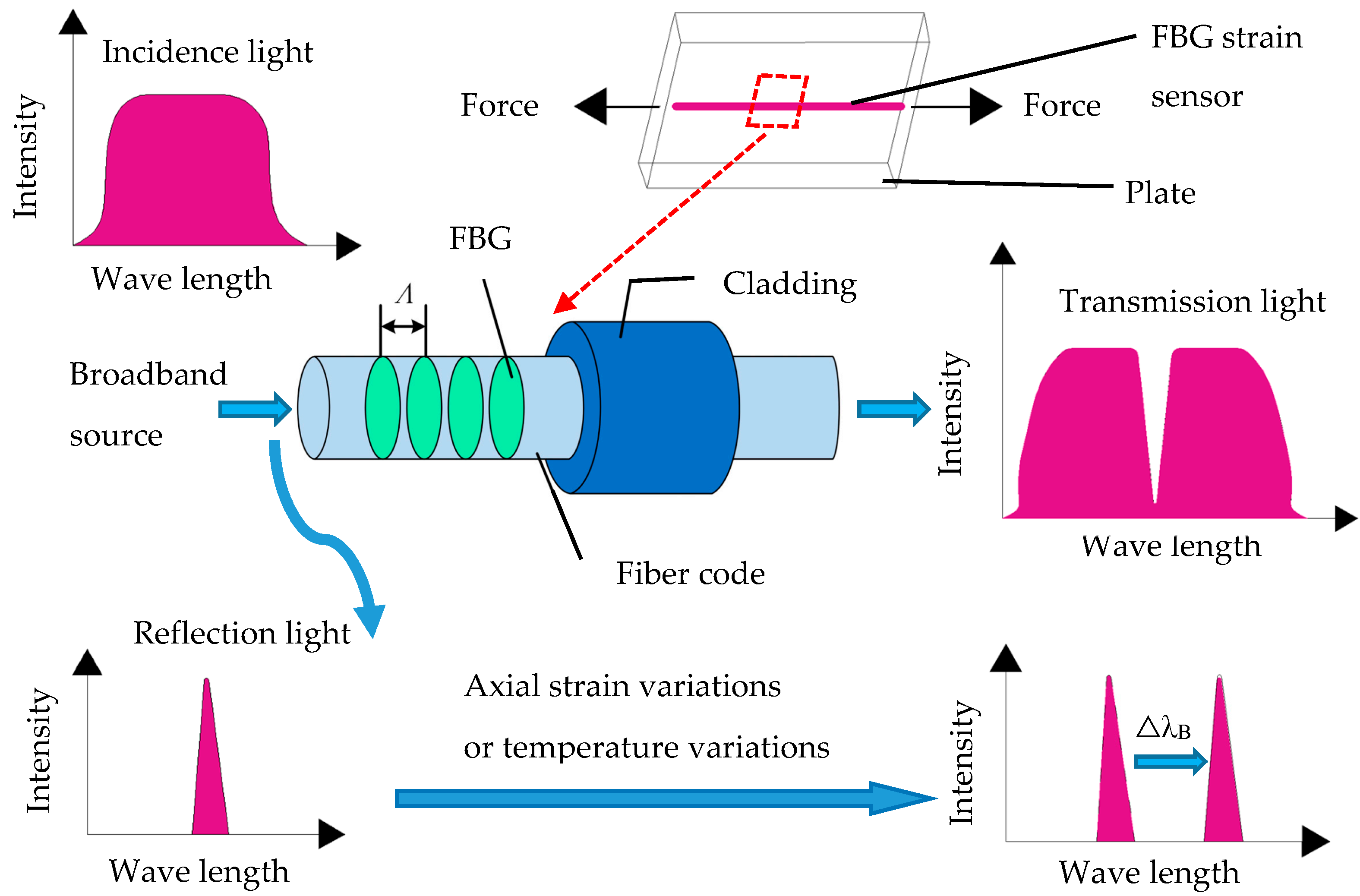
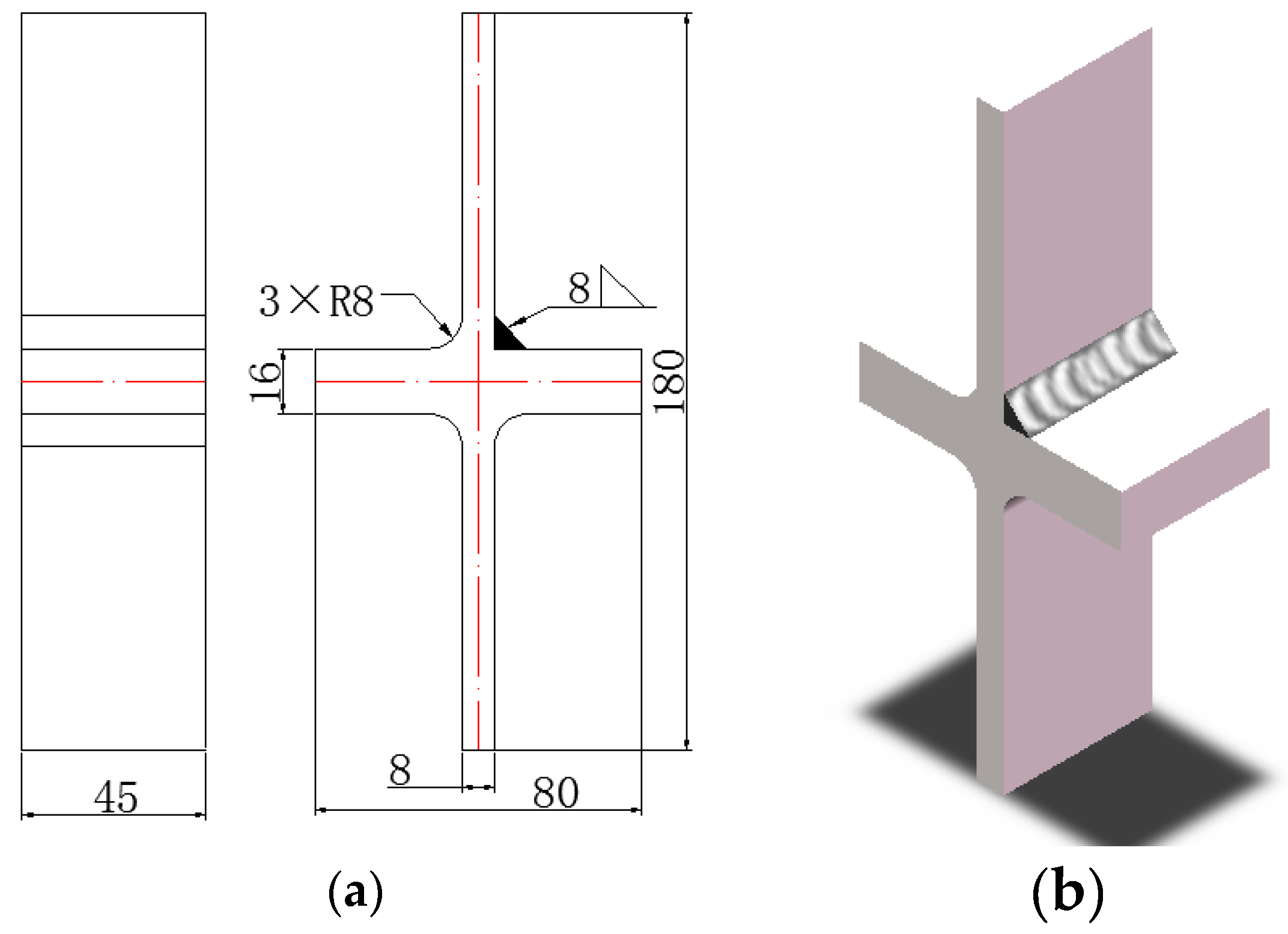
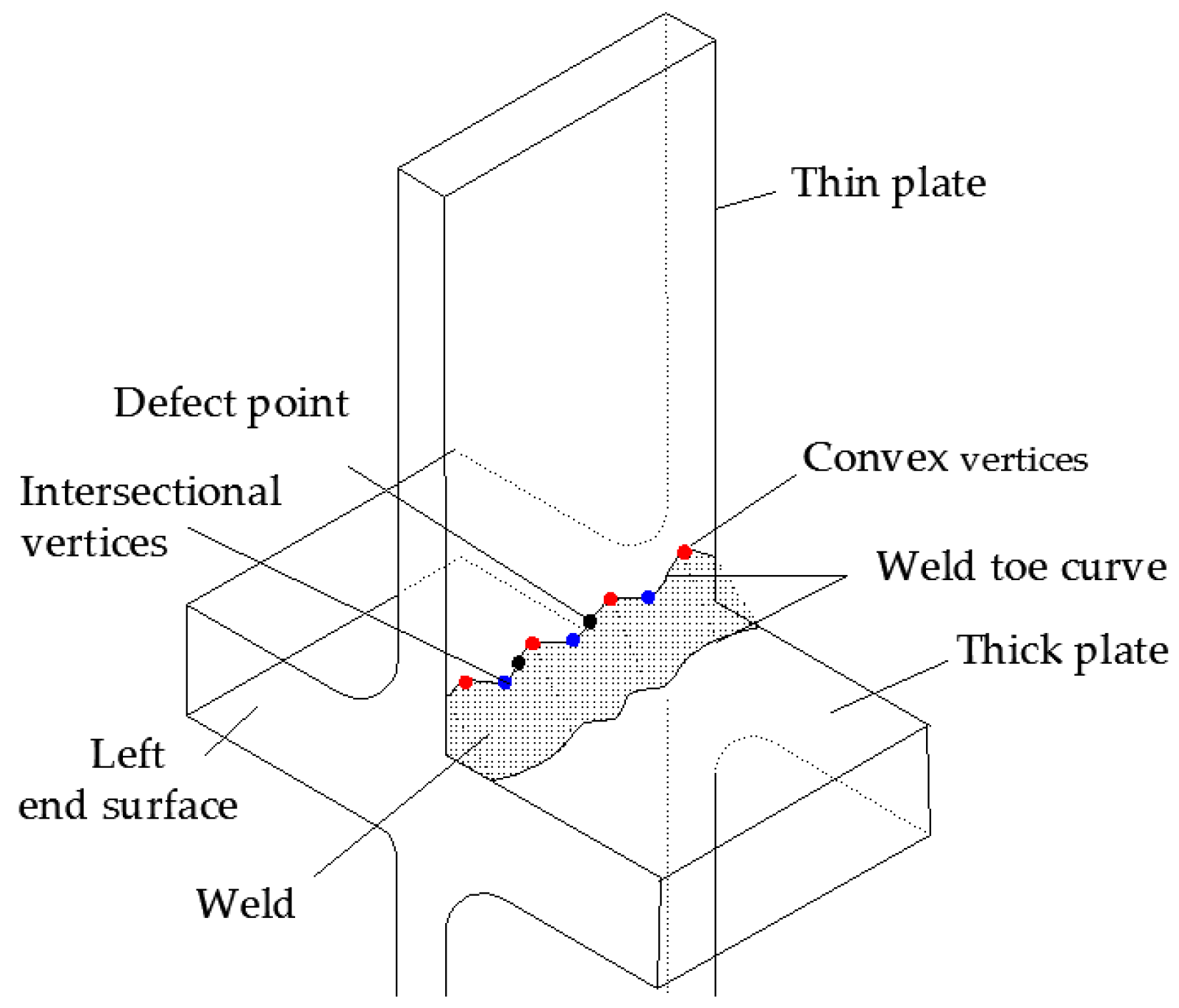
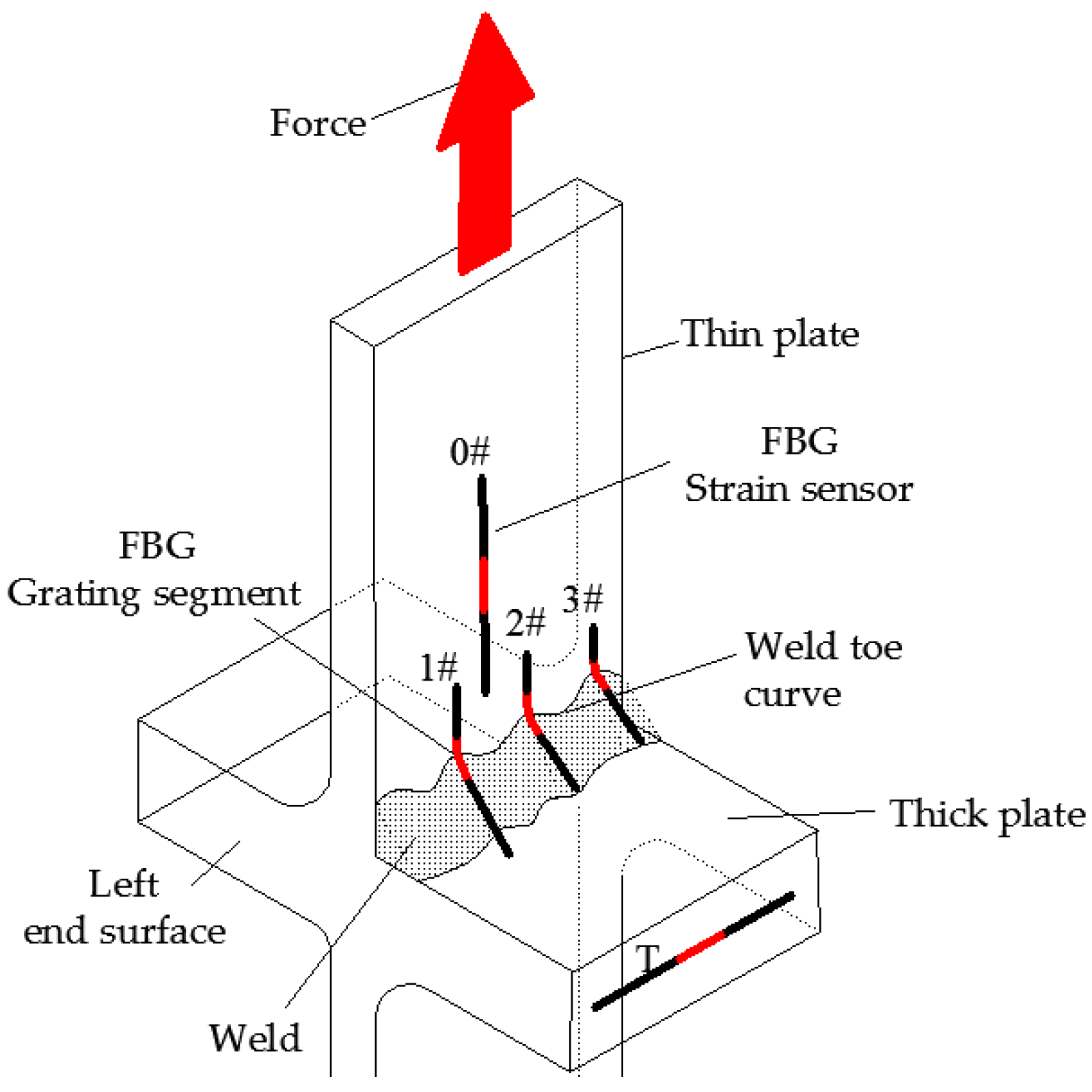
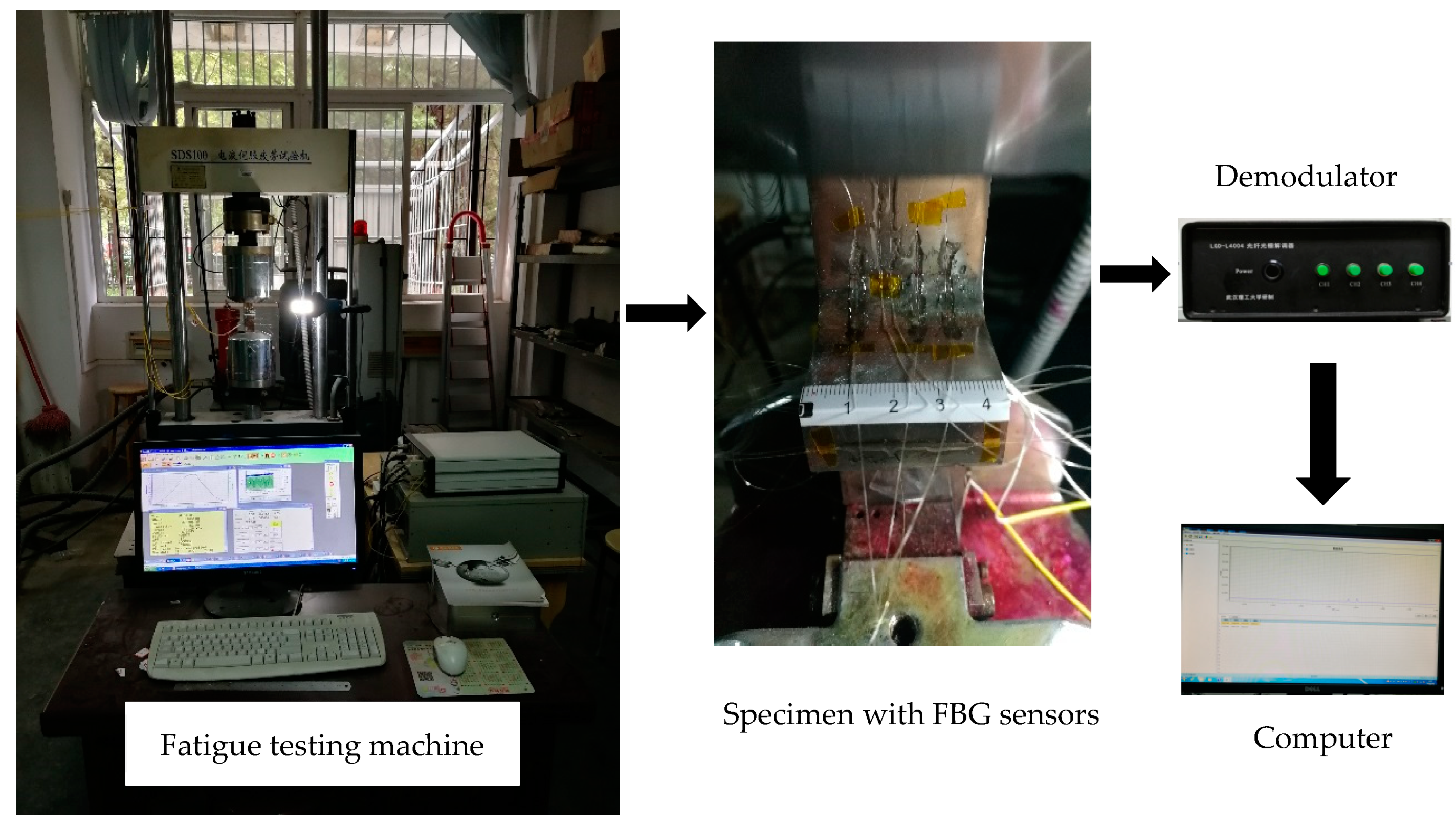
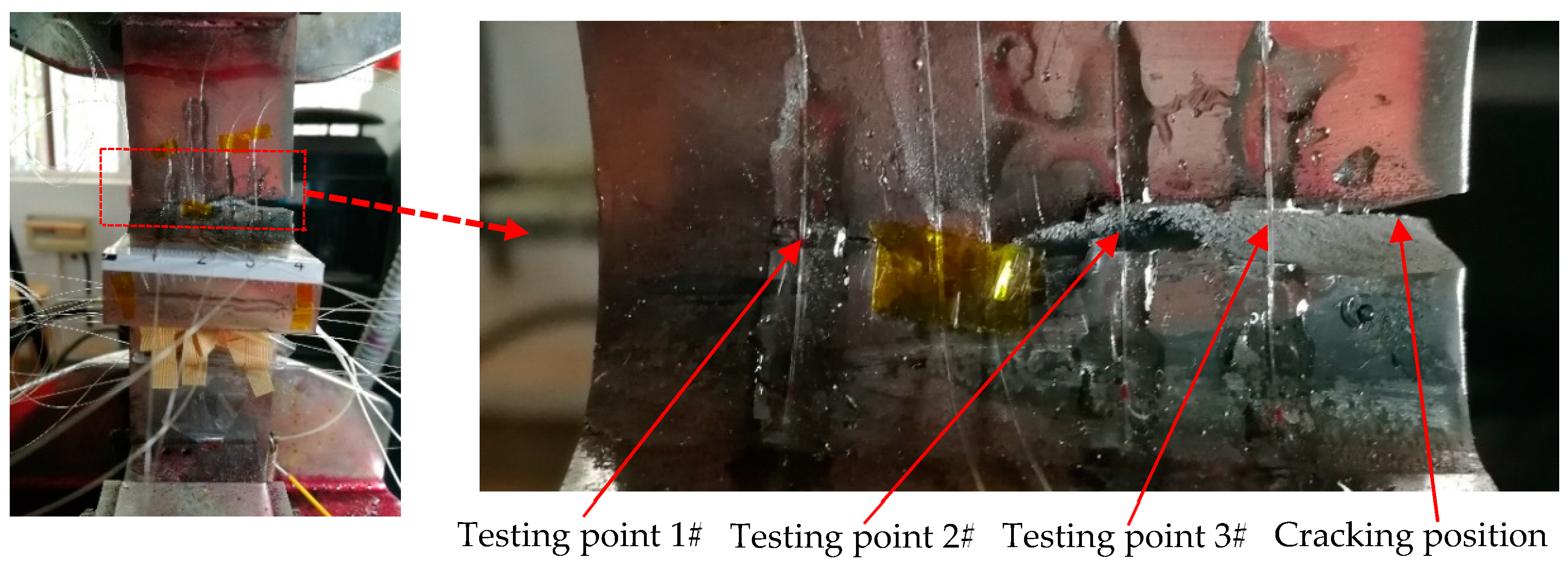

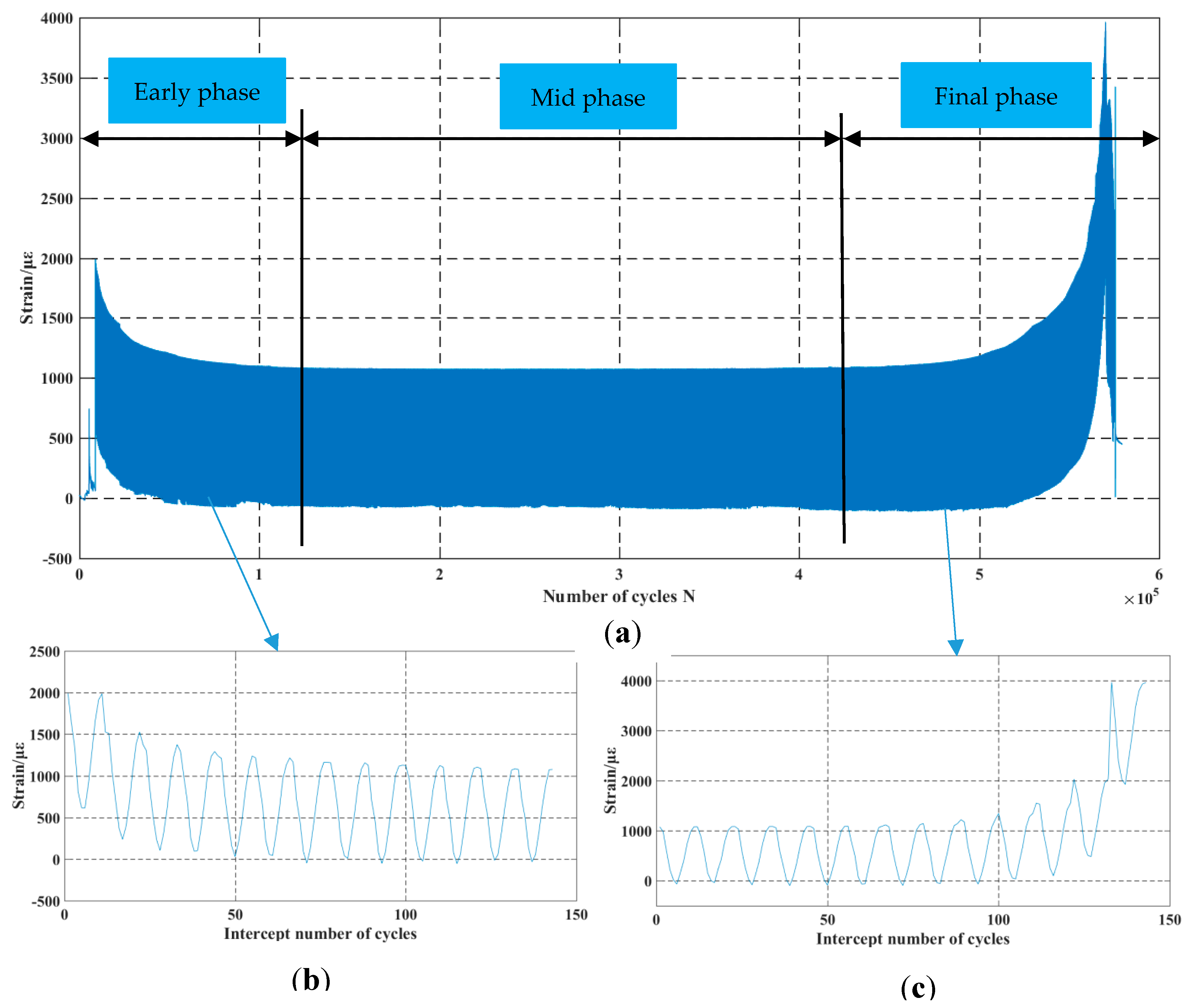
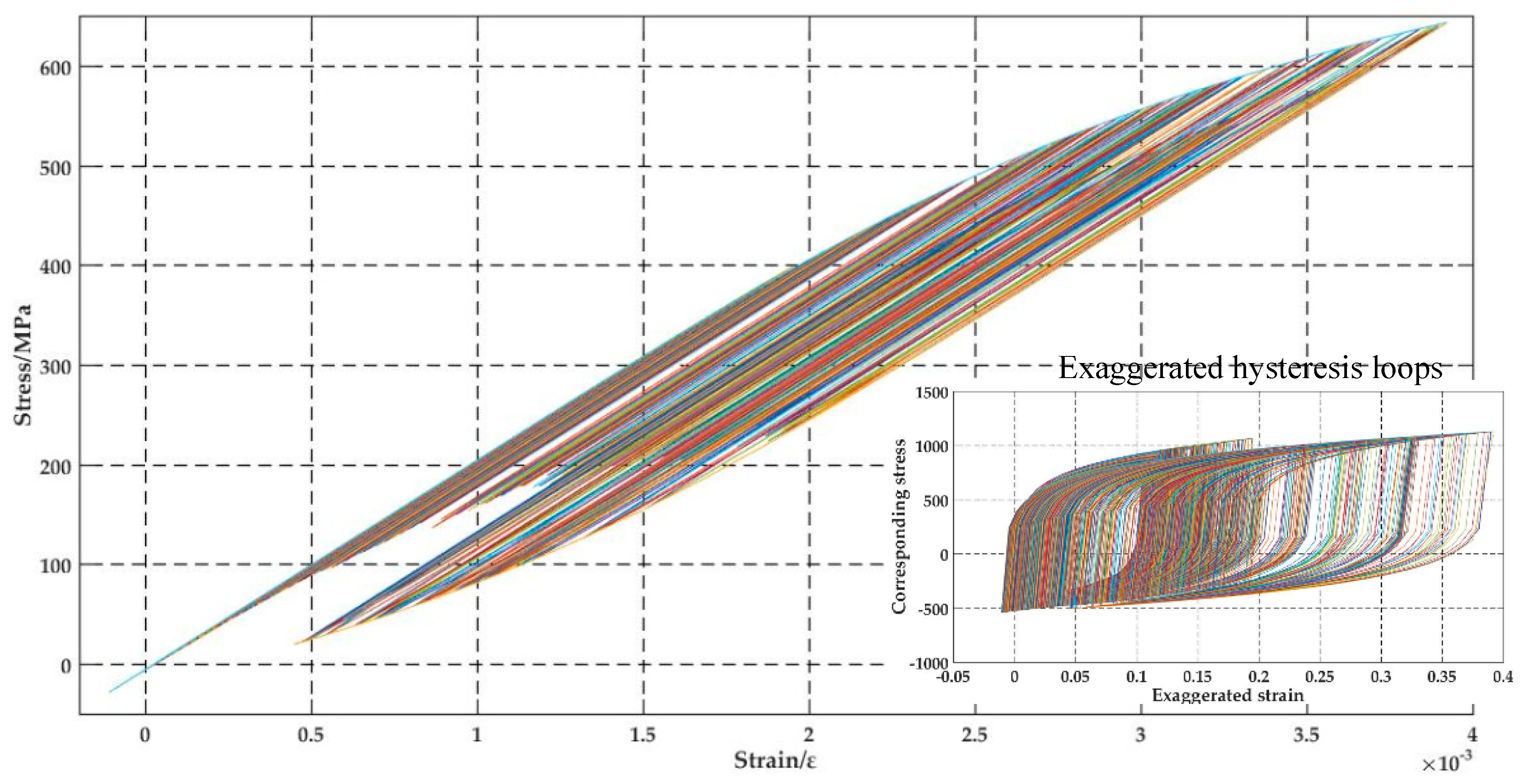
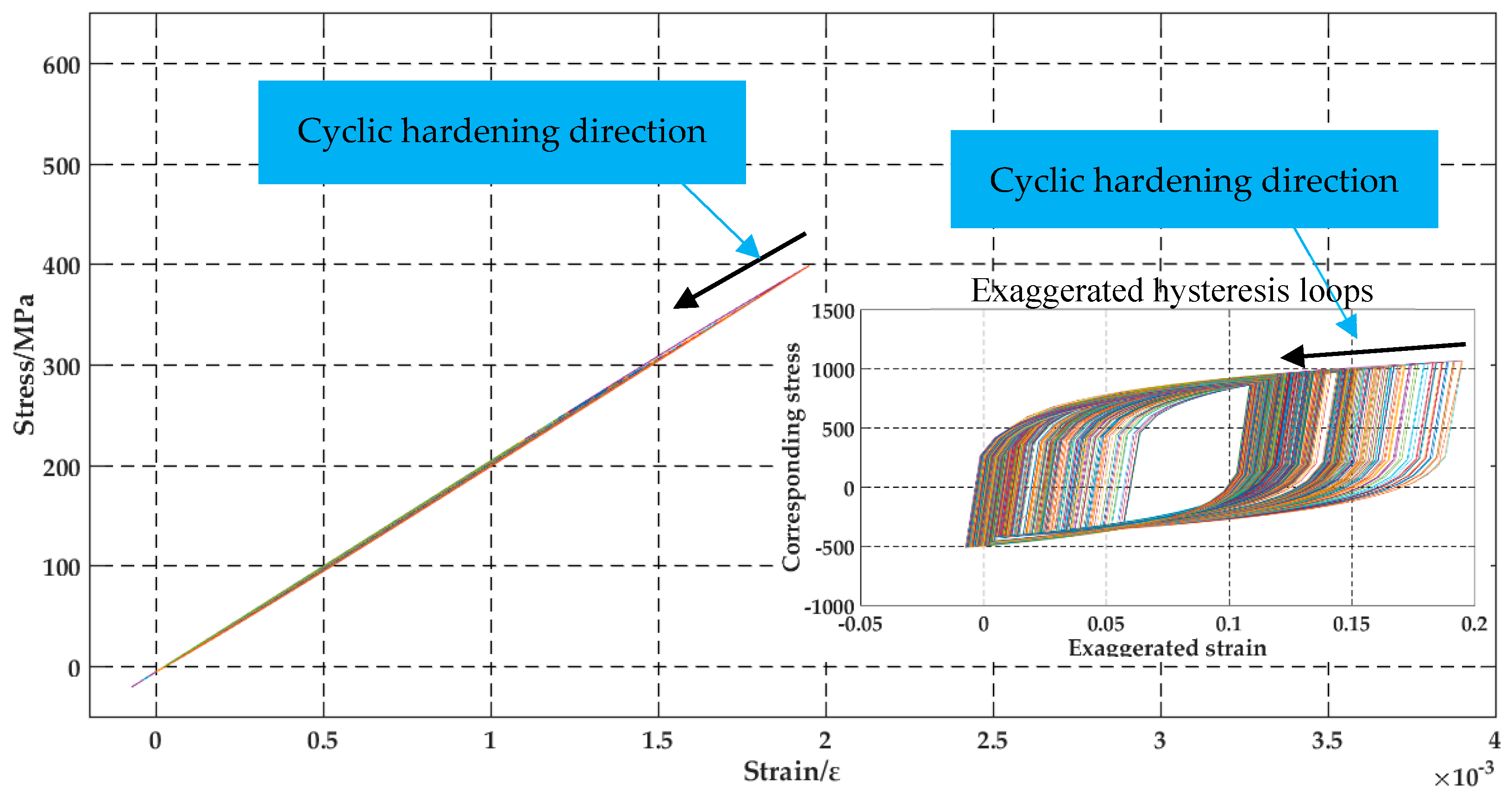
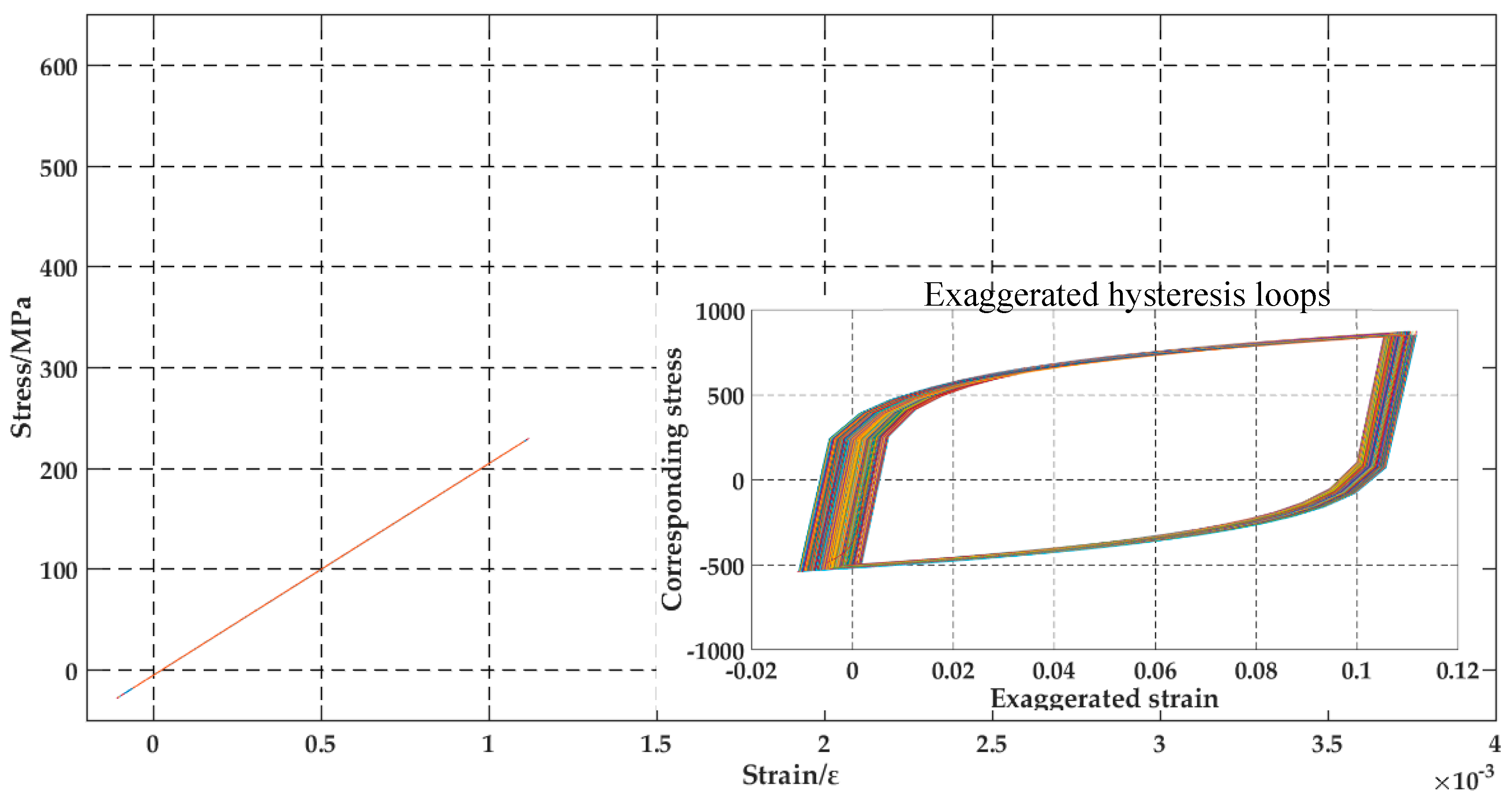
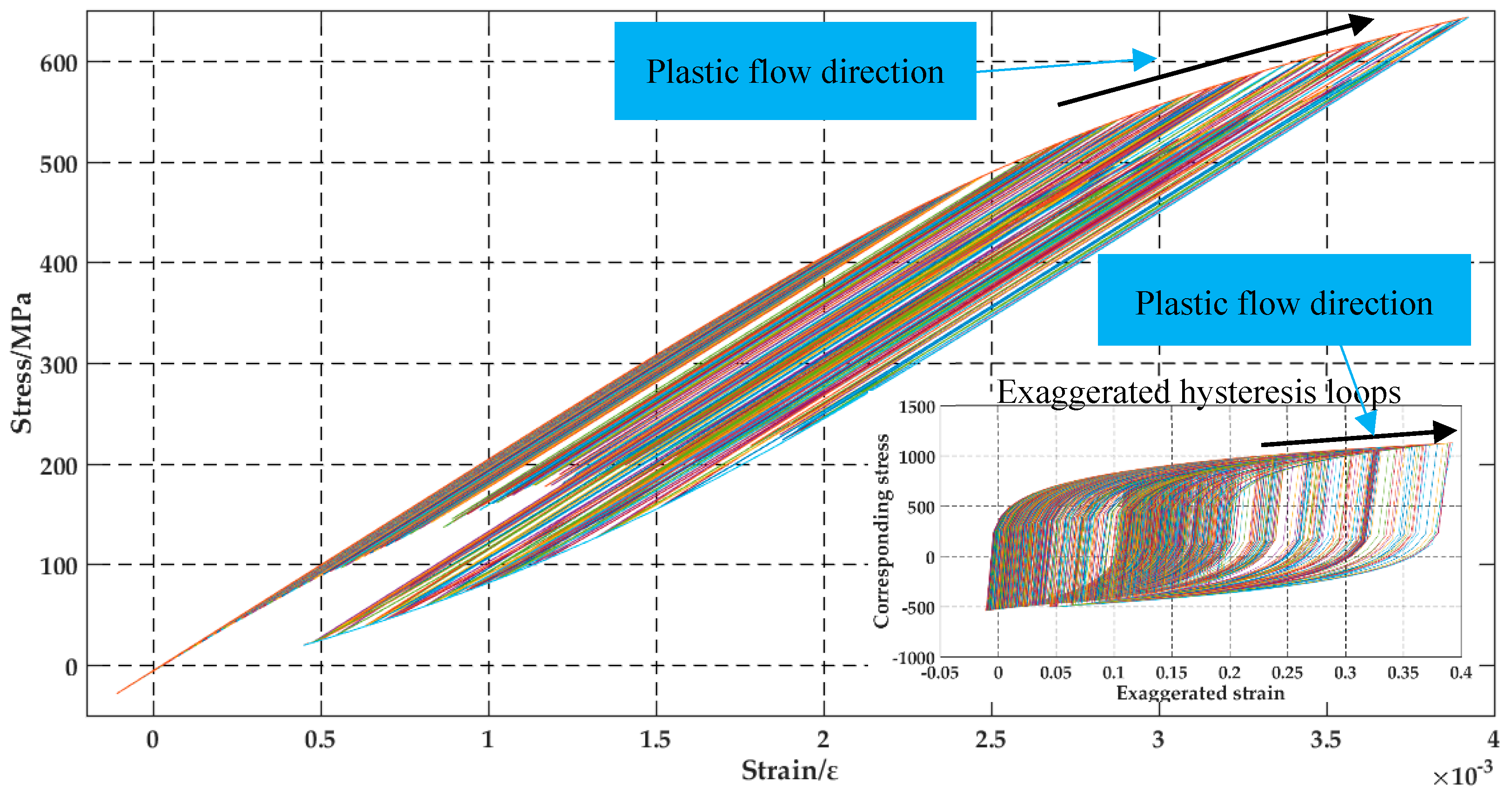
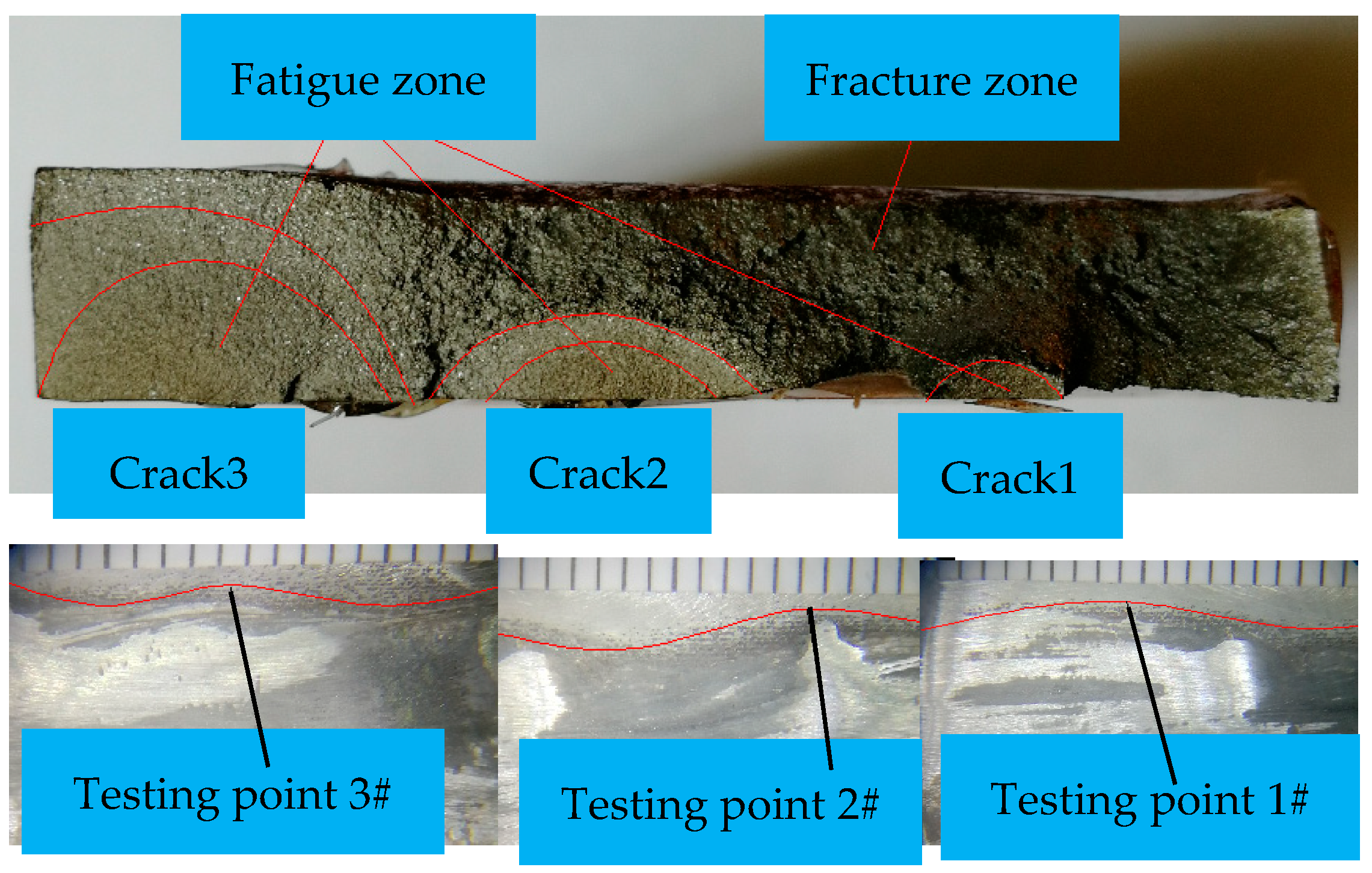
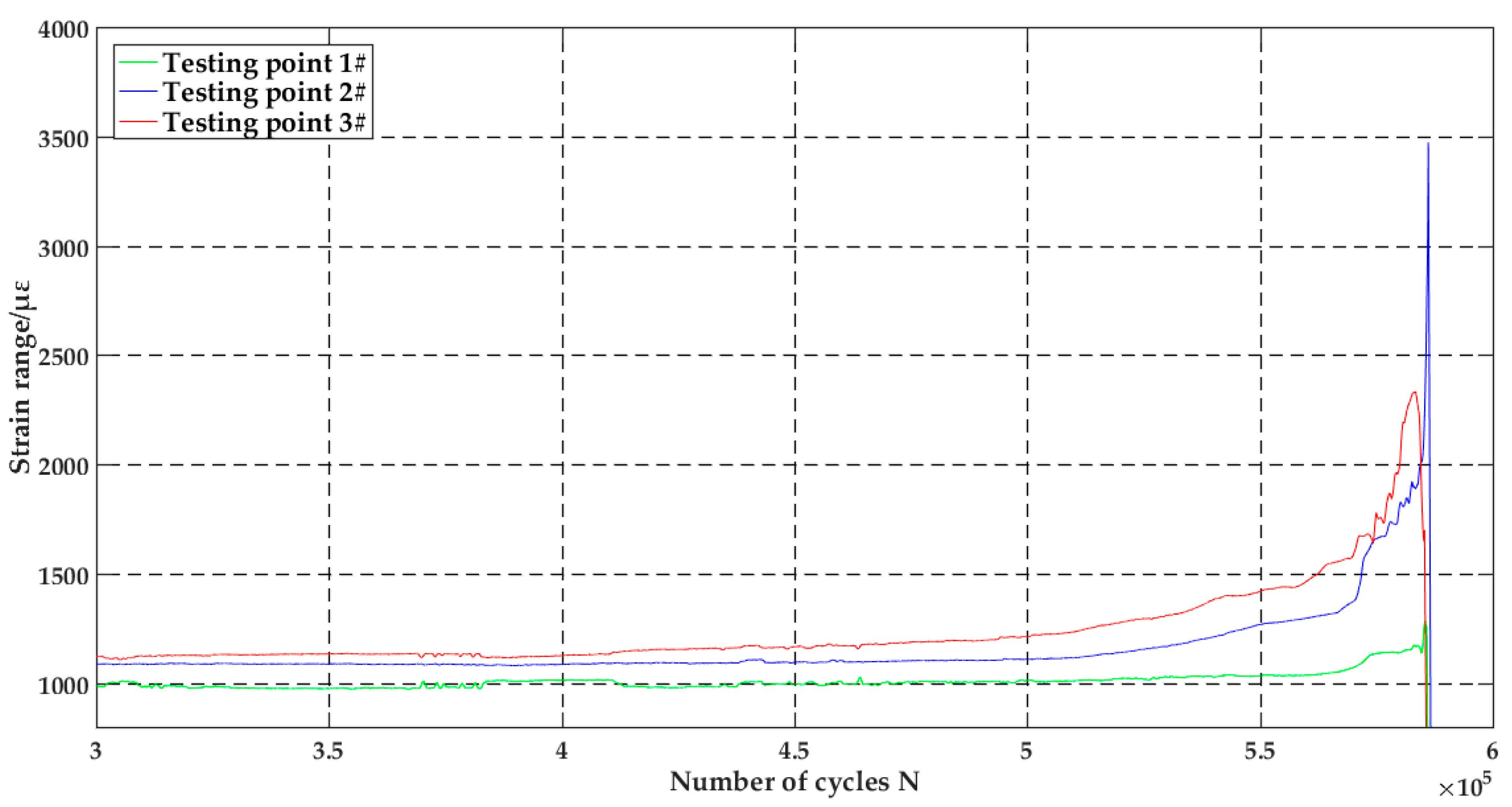
| (%) | E (MPa) | (MPa) | ||||
|---|---|---|---|---|---|---|
| 385 | 540 | 25.5 | 2.06 × 105 | 0.3 | 1281 | 0.2069 |
| C | Si | Mn | P | S | Al |
|---|---|---|---|---|---|
| 0.16 | 0.35 | 1.34 | 0.16 | 0.06 | 0.0004 |
| No. | 1 | 2 | 3 | 4 | 5 | 6 | 7 | 8 | 9 | 10 | 11 | 12 |
|---|---|---|---|---|---|---|---|---|---|---|---|---|
| L (mm) | 3.2 | 5.8 | 9.1 | 14.6 | 17.4 | 26.9 | 28.7 | 30.5 | 34.8 | 36.9 | 40.3 | 42.2 |
| T (mm) | 7.98 | 8.28 | 8.32 | 8.16 | 8.00 | 8.42 | 7.92 | 8.26 | 8.24 | 7.86 | 8.12 | 8.08 |
| θ (°) | 42.81 | 45.61 | 43.23 | 42.43 | 42.57 | 43.92 | 42.42 | 42.63 | 45.36 | 43.04 | 42.39 | 46.47 |
| l (mm) | 7.74 | 7.43 | 7.82 | 7.26 | 7.51 | 7.46 | 7.03 | 7.53 | 8.32 | 8.04 | 7.13 | 7.48 |
| ρ (mm) | 1.08 | 1.14 | 1.04 | 1.12 | 1.11 | 1.05 | 1.13 | 1.12 | 0.91 | 1.03 | 1.10 | 1.12 |
| Kt | 1.93 | 1.95 | 1.97 | 1.92 | 1.92 | 1.98 | 1.90 | 1.93 | 2.06 | 1.95 | 1.93 | 1.95 |
| Remarks | 1# | 2# | 3# |
| No. of Testing Points | Grating Bragg Wavelength (nm) | Position of Testing Points | Purpose of Testing Points |
|---|---|---|---|
| 0# | 1547 | Surface of thin plate | Nominal stress verification |
| 1# | 1541 | L-9.1 mm | Local strain measuring |
| 2# | 1532 | L-26.9 mm | Local strain measuring |
| 3# | 1550 | L-34.8 mm | Local strain measuring |
| T | 1555 | Surface of thick plate | Temperature compensation |
| Number of Testing Points | “Strain Decline” Phase | “Strain Stationary” Phase | “Strain Rise and Fall Sharply” Phase | SCF | ||||||
|---|---|---|---|---|---|---|---|---|---|---|
| εmax | εmin | Δε | εmax | εmin | Δε | εmax | εmin | Δε | ||
| 0# | 953 | 23 | 930 | 986 | 5 | 981 | 2346 | 1361 | 985 | 1 |
| 1# | 1351 | 219 | 1132 | 954 | −55 | 1009 | 4584 | 3300 | 1284 | 1.42 |
| 2# | 1688 | 450 | 1238 | 1035 | −72 | 1107 | 6416 | 4338 | 2078 | 1.77 |
| 3# | 1990 | 616 | 1374 | 1078 | −81 | 1159 | 3962 | 1925 | 2037 | 2.09 |
| Phase | No. of Testing Point | Begin Cycle | End Cycle | Strain (με) | Stress (MPa) | ||||||
|---|---|---|---|---|---|---|---|---|---|---|---|
| εmax | εmin | Δεmax | Δεmin | σmax | σmin | Δσmax | Δσmin | ||||
| Strain decline | 1# | 1 | 57,155 | 1354 | 423 | 1356 | 981 | 283 | 78 | 286 | 202 |
| 2# | 1 | 67,036 | 1687 | 453 | 1696 | 1081 | 346 | 87 | 353 | 221 | |
| 3# | 1 | 80,472 | 1951 | 569 | 1970 | 1110 | 398 | 108 | 407 | 232 | |
| Strain stationary | 1# | 57,156 | 492,616 | 953 | −15 | 1002 | 9559 | 198 | −6 | 210 | 200 |
| 2# | 67,037 | 477,499 | 1035 | −33 | 1099 | 1053 | 210 | −14 | 232 | 223 | |
| 3# | 80,473 | 458,382 | 1075 | −81 | 1148 | 1094 | 220 | −23 | 240 | 230 | |
| Strain rise and fall sharply | 1# | 492,617 | 566,742 | 4538 | 3212 | 4625 | 0 | 692 | 414 | 711 | 0 |
| 2# | 477,500 | 566,742 | 6368 | 4315 | 6466 | 0 | 771 | 381 | 800 | 0 | |
| 3# | 458,383 | 566,742 | 3924 | 1923 | 4034 | 0 | 639 | 234 | 670 | 0 | |
© 2019 by the authors. Licensee MDPI, Basel, Switzerland. This article is an open access article distributed under the terms and conditions of the Creative Commons Attribution (CC BY) license (http://creativecommons.org/licenses/by/4.0/).
Share and Cite
Wei, G.; Li, S.; Guo, Y.; Dang, Z. Fiber Bragg Gratings Based Cyclic Strain Measuring of Weld Toes of Cruciform Joints. Appl. Sci. 2019, 9, 2939. https://doi.org/10.3390/app9142939
Wei G, Li S, Guo Y, Dang Z. Fiber Bragg Gratings Based Cyclic Strain Measuring of Weld Toes of Cruciform Joints. Applied Sciences. 2019; 9(14):2939. https://doi.org/10.3390/app9142939
Chicago/Turabian StyleWei, Guoqian, Shanshan Li, Yongxing Guo, and Zhang Dang. 2019. "Fiber Bragg Gratings Based Cyclic Strain Measuring of Weld Toes of Cruciform Joints" Applied Sciences 9, no. 14: 2939. https://doi.org/10.3390/app9142939
APA StyleWei, G., Li, S., Guo, Y., & Dang, Z. (2019). Fiber Bragg Gratings Based Cyclic Strain Measuring of Weld Toes of Cruciform Joints. Applied Sciences, 9(14), 2939. https://doi.org/10.3390/app9142939





